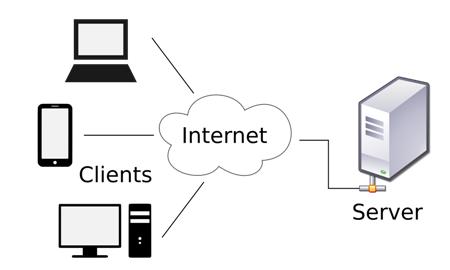 Despite the fact that both PHP Development and Nodejs Development can oversee applications of any nature, they are worked around various ideas and architectures. In the event that you are an application proprietor picking between these two environments, you ought to know about their significant points of interest and limits.
Despite the fact that both PHP Development and Nodejs Development can oversee applications of any nature, they are worked around various ideas and architectures. In the event that you are an application proprietor picking between these two environments, you ought to know about their significant points of interest and limits.
Node.js and PHP are two exceptionally mainstream development languages. PHP, a scripting dialect made by Rasmus Lerdorf in 1994, was one of the best dialects of the Web 1.0 time. The expressive indication of the PHP achievement is CMS (Content Management Systems, for example, WordPress, Joomla or Drupal that power a great many online blogs and web-based interfaces.
Node.js is younger development trend. Node.js isn’t a language, yet a runtime domain that uses JavaScript for the server-side application improvement. Propelled in 2009, Node.js has exhibited the intensity of JavaScript in building occasion-based, information-driven, I/O-overwhelming applications for the Web 2.0 time.
Node.js Pros
1. Faster Server Solutions
JavaScript occasion circle are used by Node.js to create non-blocking I/O applications. It can without much effort monitor various simultaneous occurrences. Utilizing JavaScript worked in nonconcurrent preparing, one can make profoundly adaptable server-side arrangements that augment the use of a solitary CPU and PC memory while adjusting more simultaneous solicitations than regular multithreaded servers.
This usefulness makes Node.js an awesome fit for offbeat, information-driven applications and substantial I/O-bound work processes, for example, RTAs (Real-time Applications) or SPAs (Single-page Applications), where Node guarantees amazing runtime execution.
2. Single Language for the whole Stack
Numerous mainstream client-side frameworks, for example, Ember, React and Angular are composed in JavaScript which is the fundamental dialect of present-day programs. While utilizing Node.js server-side, you have every one of the advantages of one scripting dialect over your application improvement stack.
Having a similar dialect both on the front and the back-end is superb for the practicality of your application and coordination between colleagues both frontend and backend designers work with the same JavaScript information structures, capacities, colloquial articulations, and dialect traditions. All that adds to quicker application improvement, bug settling, and coordination inside your building group.
3. Flexibility
Node.js accompanies a couple of hard conditions, principles, and rules, which leaves the space for flexibility and inventiveness in building up your applications. Node.js does enable developers to choose the best development, outline examples, modules and highlights for your next project. With it, your Node.js designing group will approach a great many modules for any possible purposes through the NPM archive
Node.js Cons
1. Not efficient for Applications needing more CPU
It is an event based single-thread structure that isn’t as great in dealing with CPU escalated tasks, for example, creating or altering graphics, sound, and video as in overseeing simultaneous requests. When preparing extensive records or doing activities with graphics, Node.js applications may wind up sluggish. At whatever point you are contemplating designs applications, a multi-threaded environment is a superior choice than Node.js.
2. Immature
Alongside stable centre libraries, similar to HTTP or Crypto, Node repository gives access to a group of outsider modules created by the network. This biological system of modules is still genuinely youthful. It’s difficult to survey the nature of a specific module before application organization. Also, unobtrusive bugs and version irregularity may crawl into applications making it hard to look after them.
The simplicity of distributing your own particular bundles combined with the absence of a solid instrument of module’s endorsement implies that you should give careful consideration while choosing bundles to ensure that they had an ongoing action, for example, bug fixes and refreshes.
PHP Pros
1. A very Rich Code Base
PHP has a powerful code base that including website design platforms like WordPress, Joomla, Drupal and web development frameworks (Laravel, Symfony) enabling Rapid App Development. CMS (Content Management Systems) for example, WordPress, simplifies a blog or an e-commerce site deployment in just a few minutes and permits non-developers customizations. Additionally, there are numerous PHP applications offered by hosting stages, for example, the cPanel that is installable in a click.
2. Portable Solution
PHP is an exceedingly portable application development arrangement. It can be kept running on any server (Nginx, Apache) and every stage (Windows, Linux). This means you have to write your code just once and run it anywhere.
At the same time, there is a wide hosting help for PHP. A number of hosting providers offer shared hosting alternatives for PHP, yet you need a virtual server with SSH access to run Node.js applications. Thus, integrating and deploying PHP is easier for small businesses or people who run and manage their own apps with no knowledge of SSH (Secure Shell), console orders, and Linux server technologies which are considered a preferred choice for Node.js.
3. Designed for the Web
Unlike Java or Python and other general-purpose programming languages, PHP was designed specifically to function admirably on the Web. That is the reason it includes all needed usefulness to manage HTML, servers and databases (MySQL specifically). With a comprehensive server-side arrangement like PHP, there is likewise no need to bother about JavaScript in the browser since all pages can be easily generated and rendered on the server.
This is useful in the event that you need to abstain from overloading of the client side. At the same time, heavy server-side rendering and regular requests to the server to generate and render pages probably won’t be a decent alternative for Single Page Applications (SPAs) with rich client-side usefulness for which JavaScript is frequently a better choice.
PHP Cons
1. Separation of Concerns (SoC) is inefficient
PHP is for not suited for implementing MVC (Model-View-Controller) approach which prescribes clear Separation of Concerns (SOC) between information, behavior, and representation. MVC is a de facto best practice in web development that ensures readability, viability, and versatility of web applications. However, in PHP it will blend HTML and language sentence structure inside HTML files, which rapidly results in the ineffectively maintainable code where views and business rationale are not separated. As a result, it’s difficult to extend PHP applications with new usefulness and manage applications with a large code base.
2. Outdated Client-Server Model
PHP takes after the traditional client-server model where every page request initiates the application, database connection, arrangement parameters and HTML rendering. This makes PHP somewhat slower in contrast with a Node.js application that runs permanently and needs just to initialize once. On account of these features, Node.js is more suitable for state-of-the-craftsmanship HTML5 features, AJAX and WebSocket. The problem might be handled in PHP by means of Memcached; however, this is anything but a standard feature of the PHP language.
So, How to choose between them?
As you have seen, both Node.js and PHP have their great and awful parts. Provided that this is true, how would we make the correct choice? It’s possible in the event that we leverage our knowledge of both the environment’s architectures and ecosystems.
Specifically, the event-based architecture of Node qualifies it to be a great fit for RTA (Real-Time Applications, for example, texting and collaborative applications (drawing and video conferencing) in which numerous requests are happening concurrently and where information is frequently shuffled forward and backward from the server to the client.
It is easy to implement bar sub (distribute subscribe) architectures used in RTAs and rapidly update the view on the client side as Node.js supports server-side events and WebSocket. The same features make Node.js suitable for applications that process information from IoT (Internet of Things) and Single Page Applications (SPAs) that involve exceptionally flexible, dynamic and heavy client-side usefulness.
It’s additionally very simple when implementing web services with Node.JS in which the server-side capacities as a REST API that provides the connection between the client and a database and where the speed of CRUD operations and offbeat processing is of great importance.
In its turn, PHP is a decent choice for a standardized arrangement, for example, a blog, news site, point of arrival or web entry. With such CMS (Content Management System) as WordPress written in PHP, you can create stable and customizable websites without a lot of coding. On the off chance that you need more customization, WordPress provides a well-documented API to change application’s structure, presentation, modules, etc.
As a reward, the WordPress people group has created a great many customizable themes that open infinite opportunities for web designers. If time is limited, you can develop an app from a blog to an online retail website CMS and other tools created in PHP. PHP is likewise a better choice if hosting support is the issue. On the off chance that your client needs a shared hosting service instead of an undeniable virtual cloud instance, PHP provides more flexibility in integration and deployment.
In this way, when picking between Node.js and PHP, you should consider what type of utilization you will fabricate, what are the hosting requirements of your client, and what is the speed of development. In the event that your client is searching for a standardized arrangement with an extensive hosting support, you ought to consider utilizing PHP. Then again, Node.js is a better choice for RTAs (Real-time Applications, for example, visits, joint effort applications and SPAs (Single-page Applications).
Contributed byhttps://www.techtiq.co.uk/









